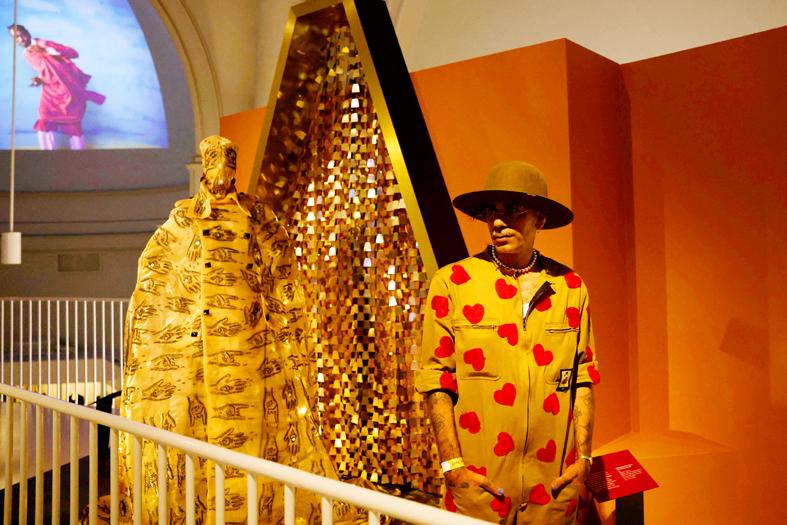Britain’s most extensive exhibition of African fashion is set to open in London, showcasing designers past and present, as well as the continent’s diverse heritage and cultures.
“Africa Fashion” at the Victoria and Albert (V&A) Museum from Saturday is also the UK’s first exhibition dedicated to the medium.
Project curator Elisabeth Murray said the show would provide a “glimpse into the glamor and politics of the fashion scene.”

Photo: AFP
“We wanted to celebrate the amazing African fashion scene today. So the creativity of all the designers, stylists, photographers, and looking at the inspiration behind that,” she said.
Included in the exhibition are objects, sketches, photos and film from across the continent, starting from the African liberation years in the 1950s to 1980s, to up-and-coming contemporary designers.
Senior museum curator Christine Checinska has called it “part of the V&A’s ongoing commitment to foreground work by African heritage creatives.”
Global anti-racism movements, including Black Lives Matter, have forced Britain to reassess its divisive colonial past, from museum collections and public monuments to history teaching in schools.
The V&A was founded in 1852, as Britain under queen Victoria expanded its global empire, including, in the decades that followed, in Africa, but Checinska said African creativity had “largely been excluded or misrepresented in the museum, owing to the historic division between art and ethnographic museums, arising from our colonial roots and embedded racist assumptions.”
“The conversations and collaborations that have shaped the making of the Africa Fashion exhibition are a testbed for new equitable ways of working together that allow us to imagine and call into being the V&A of the future,” she said.
Displaying a diverse range of African designs, textiles and influences, the ambitious exhibition is a way to address that imbalance, she added.
The scene is set with a section on “African Cultural Renaissance,” highlighting protest posters and literature from independence movements that developed in conjunction with fashion.
“The Vanguard” is the central attraction, displaying iconic works by well-known African designers including Niger’s Alphadi, Nigeria’s Shade Thomas-Fahm and Kofi Ansah of Ghana.
A variety of African textiles and styles, such as beadwork and raffia, are employed in innovative designs with cross-cultural influences.
Other displays — with names such as “Afrotopia,” “Cutting-Edge” and “Mixology” — explore fashion alongside issues such as sustainability, gender, race and sexual identity.
One highlight is the centerpiece made by Moroccan designer Artsi especially for the exhibition. It is a piece inspired by the British trench coat and Muslim hijab, navigating how to “present Africa in England,” he said.
Fashioning a “meditation on our common humanity,” Artsi emphasizes the beauty of African fashion which “doesn’t come from a source of commercialized clothes.”
“It comes from a source of heritage and celebrating culture,” he said.

Chinese President Xi Jinping (習近平) is to visit Russia next month for a summit of the BRICS bloc of developing economies, Chinese Minister of Foreign Affairs Wang Yi (王毅) said on Thursday, a move that comes as Moscow and Beijing seek to counter the West’s global influence. Xi’s visit to Russia would be his second since the Kremlin sent troops into Ukraine in February 2022. China claims to take a neutral position in the conflict, but it has backed the Kremlin’s contentions that Russia’s action was provoked by the West, and it continues to supply key components needed by Moscow for

Japan scrambled fighter jets after Russian aircraft flew around the archipelago for the first time in five years, Tokyo said yesterday. From Thursday morning to afternoon, the Russian Tu-142 aircraft flew from the sea between Japan and South Korea toward the southern Okinawa region, the Japanese Ministry of Defense said in a statement. They then traveled north over the Pacific Ocean and finished their journey off the northern island of Hokkaido, it added. The planes did not enter Japanese airspace, but flew over an area subject to a territorial dispute between Japan and Russia, a ministry official said. “In response, we mobilized Air Self-Defense

CRITICISM: ‘One has to choose the lesser of two evils,’ Pope Francis said, as he criticized Trump’s anti-immigrant policies and Harris’ pro-choice position Pope Francis on Friday accused both former US president Donald Trump and US Vice President Kamala Harris of being “against life” as he returned to Rome from a 12-day tour of the Asia-Pacific region. The 87-year-old pontiff’s comments on the US presidential hopefuls came as he defied health concerns to connect with believers from the jungle of Papua New Guinea to the skyscrapers of Singapore. It was Francis’ longest trip in duration and distance since becoming head of the world’s nearly 1.4 billion Roman Catholics more than 11 years ago. Despite the marathon visit, he held a long and spirited

China would train thousands of foreign law enforcement officers to see the world order “develop in a more fair, reasonable and efficient direction,” its minister for public security has said. “We will [also] send police consultants to countries in need to conduct training to help them quickly and effectively improve their law enforcement capabilities,” Chinese Minister of Public Security Wang Xiaohong (王小洪) told an annual global security forum. Wang made the announcement in the eastern city of Lianyungang on Monday in front of law enforcement representatives from 122 countries, regions and international organizations such as Interpol. The forum is part of ongoing